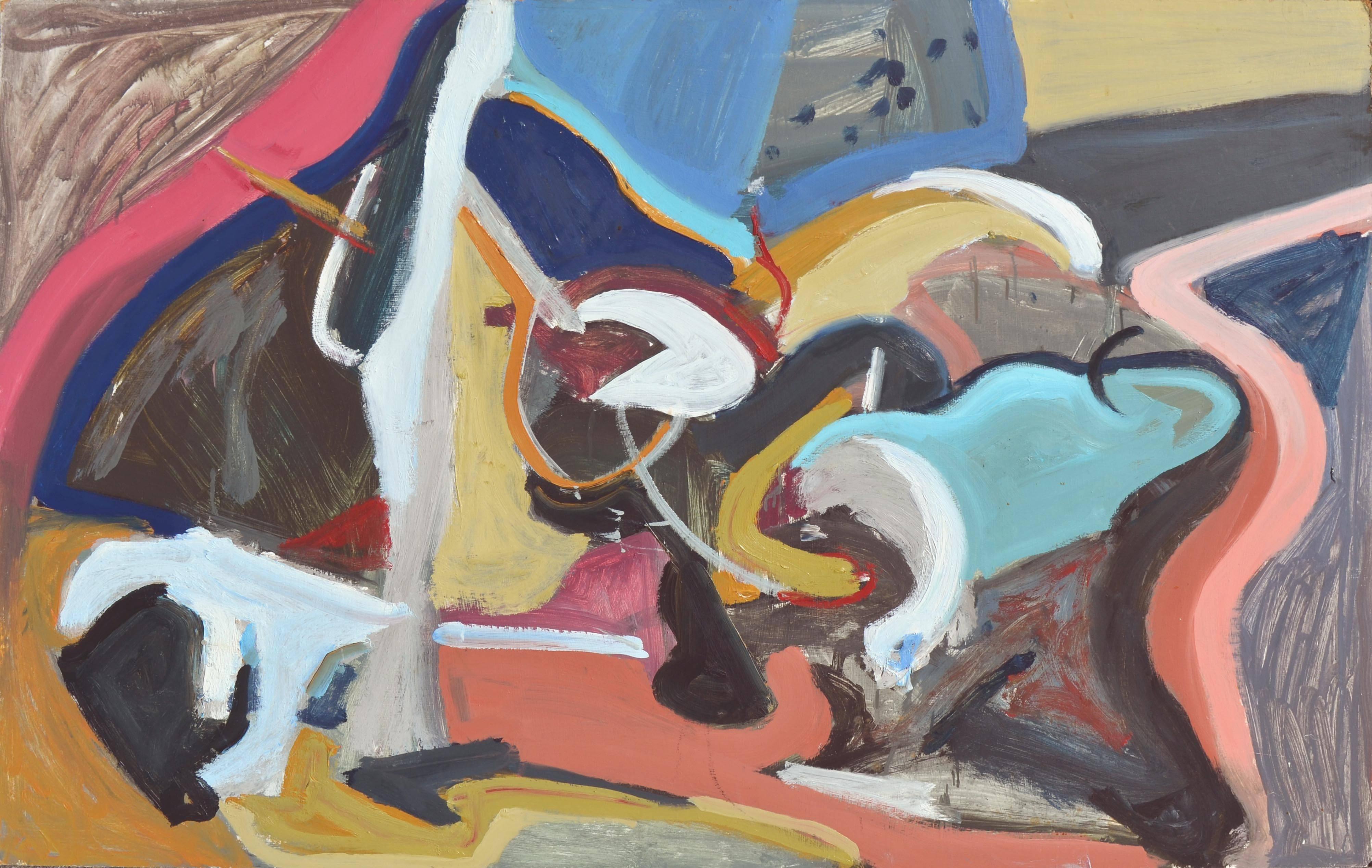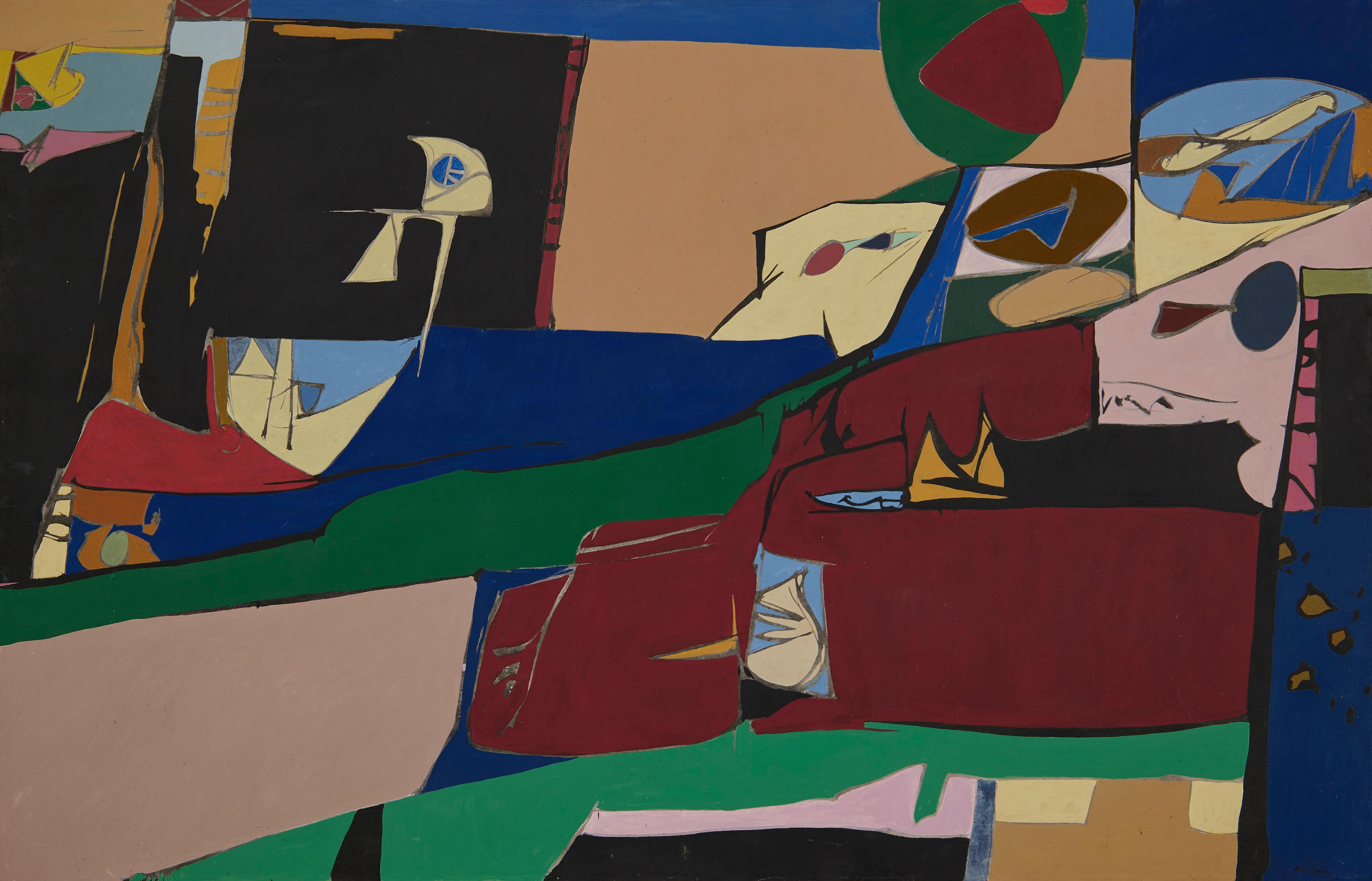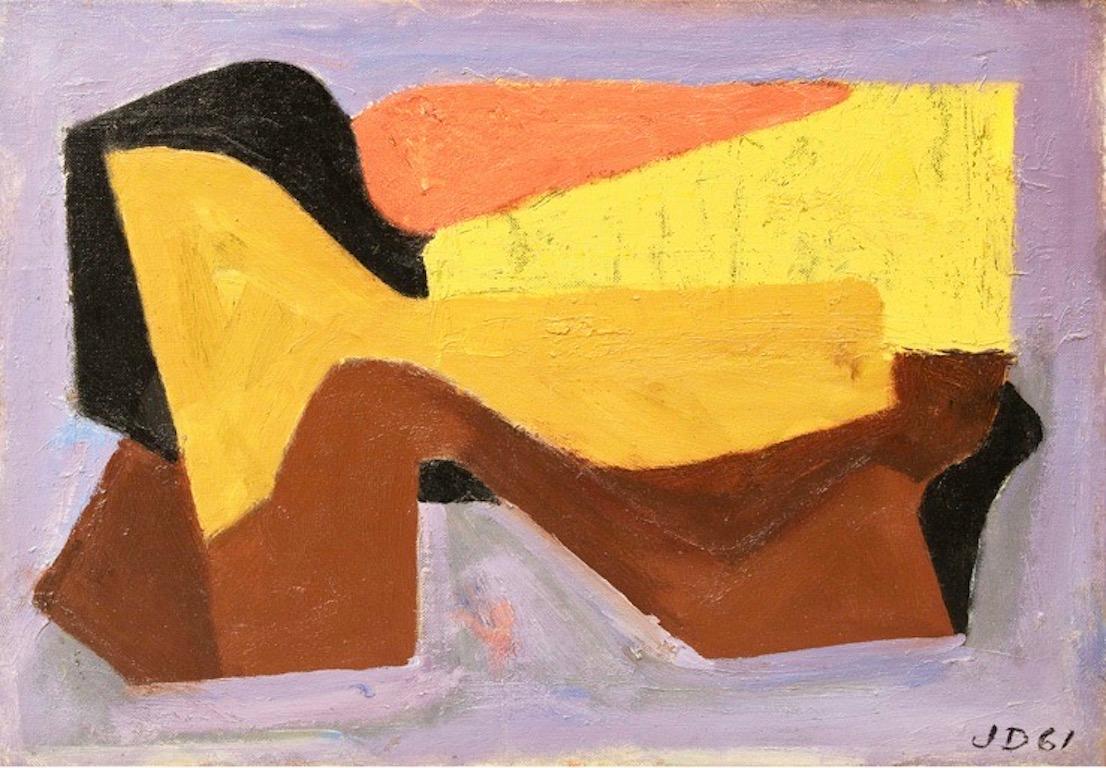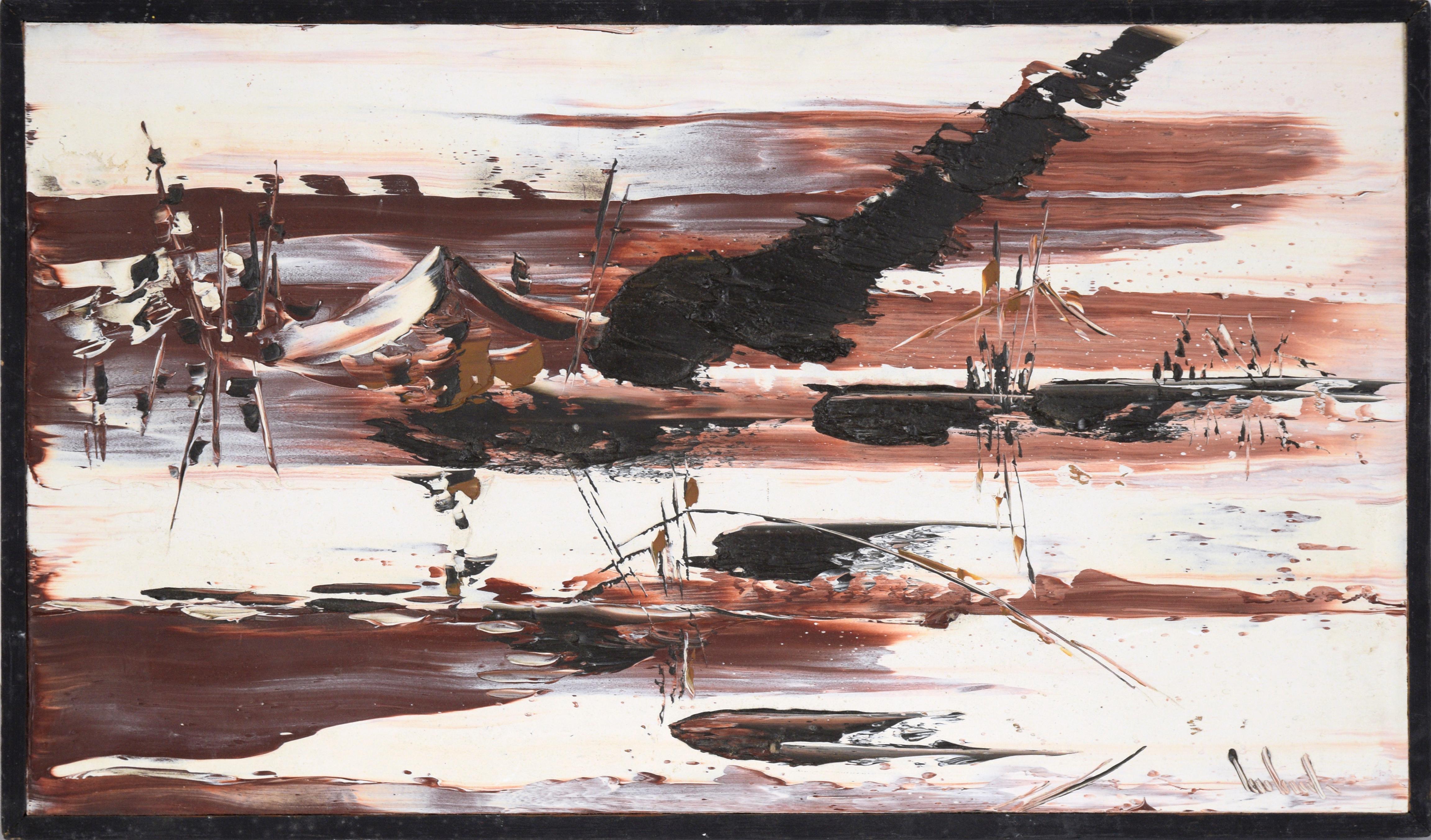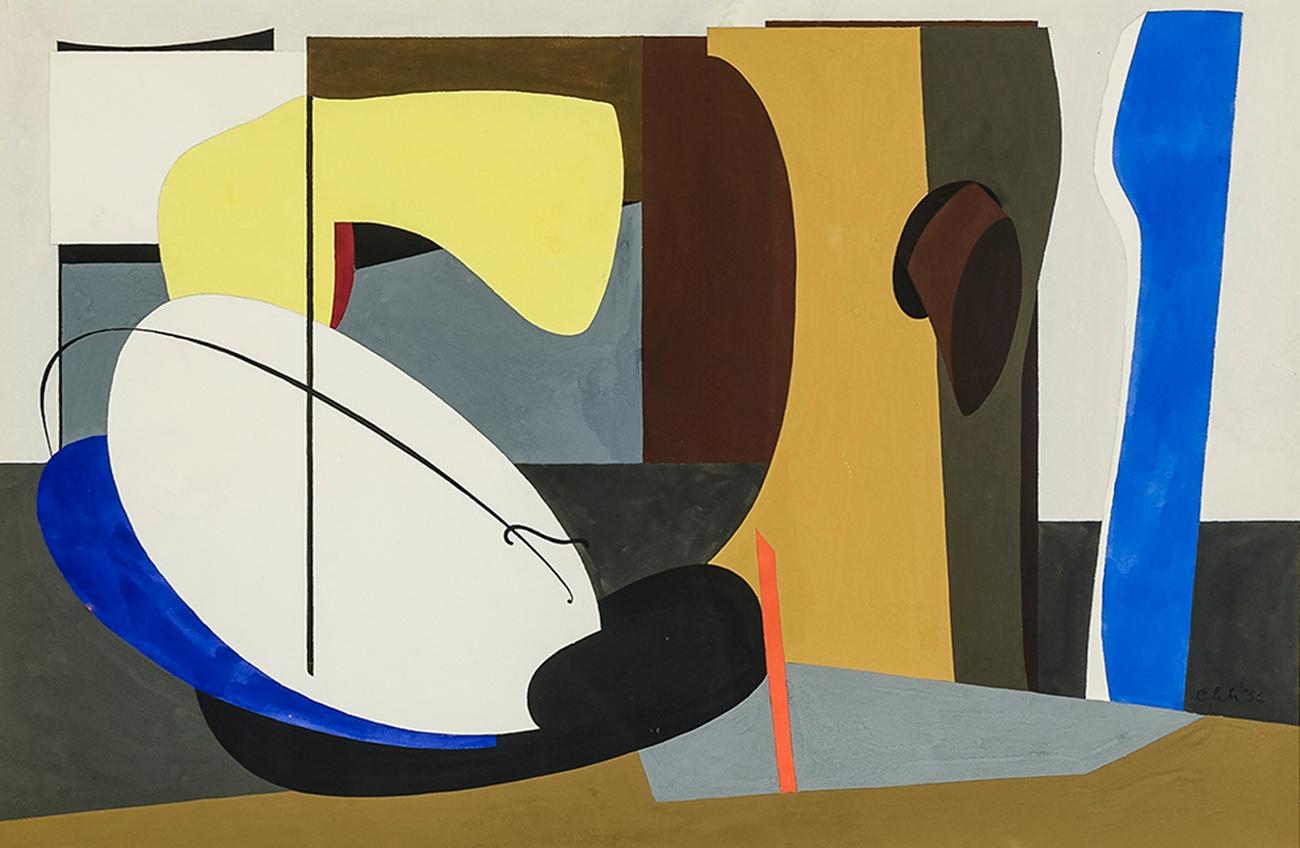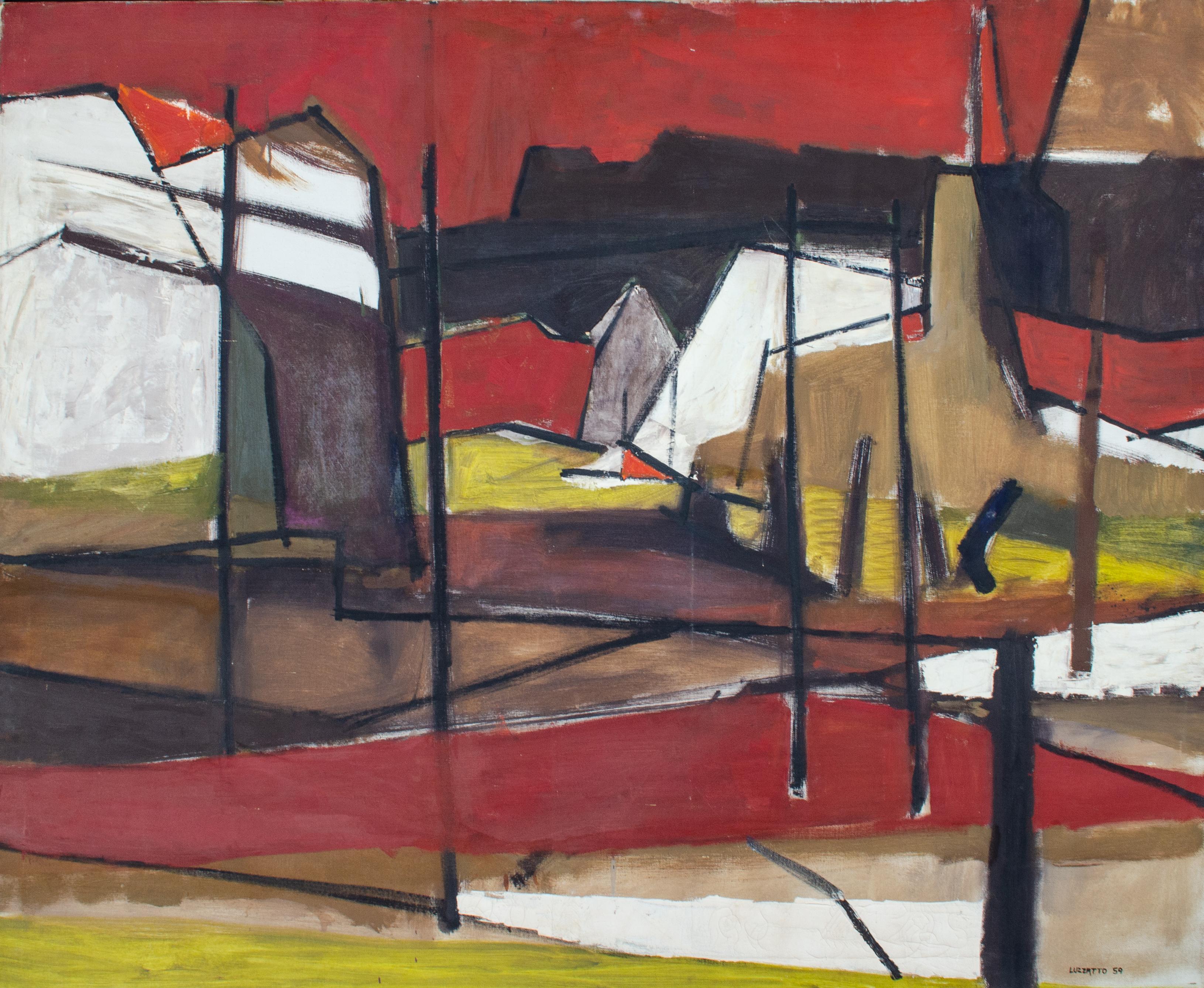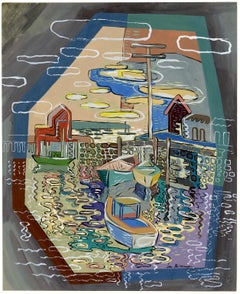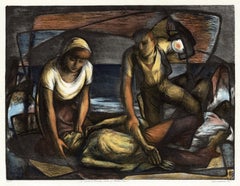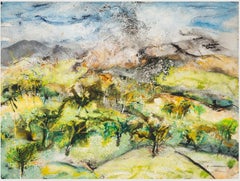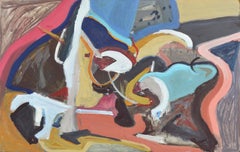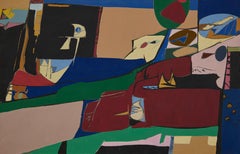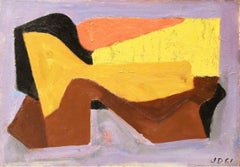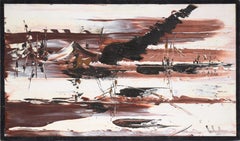Items Similar to 'Dockside' — Mid-Century Modernism
Want more images or videos?
Request additional images or videos from the seller
1 of 6
Alex Minewski'Dockside' — Mid-Century Modernism1953
1953
$3,400
£2,624.06
€2,987.34
CA$4,854.91
A$5,295.22
CHF 2,790.13
MX$63,503.85
NOK 35,131.31
SEK 32,776.80
DKK 22,310.15
About the Item
Alex Minewski, 'Dockside', gouache on paper, 1953. Signed in the image, lower left. Annotated 'April 1953, Minewski, ‘Dock Side’, verso. A fine, modernist rendering, with fresh colors, on cream wove drawing paper. Original brown paper tape on the sheet edges, recto; in excellent condition. Matted to museum standards, unframed.
Image size 14 7/8 x 22 3/16 inches (378 x 564 mm).
ABOUT THE ARTIST
“I have tried to stress the conceptual value of things ‘seen’ rather than simply what the eye ‘looks at.’ Through inner force, I hope to develop the physical image. By avoiding the picturesque, I want to reach beyond the image alone. The work, in the end, must speak for itself. Painting should be an expression of life’s experiences.”
—From the Exhibition catalog, Ulster County College, 1981.
Born in Detroit, Alex Minewski (1917-1979) left home as a teenager and joined the circus. He returned to Detroit to begin his art training at the Society of Arts and Crafts and then moved to New York City to continue his studies at the Art Students League, where his teachers included Jean Charlot, Ernest Fiene, George Grosz, and Vaclav Vytlacil. During WWII, serving as a combat engineer Minewski was wounded in Burma while fighting with the famed special operations jungle warfare unit Merrill's Marauders. While in recovery, he continued his studies on the G.I. Bill at the Grande Chaumiere in Paris. He returned to New York City to study independently with the renowned teacher and artist Hans Hofmann from 1952-1953.
In 1954, Minewski began spending summers at the historic artist’s colony in Monhegan Island, Maine. In the early 1970s, he was awarded a research grant to study the sea life on the Maine coast. He became fascinated with the structure of fish, and studies of their forms filled his Monhegan portfolio. Minewski was appointed Professor of Art at SUNY, New Paltz, in 1966, teaching there until he died in 1979.
Minewski exhibited in New York City, Maine, Detroit, and New Paltz in group and one-man shows throughout his career, including Michigan Artists, 1937-39, 1938 (purchase), 1945-47; Audubon Artists, 1947-48; Detroit Institute of Art, 1946 (solo); Contemporary Art Gallery, 1947; PAFA Annual, 1949; National Society of Painters in Casein, 1955, 1956; Ball State Teachers College, 1956 (purchase); Butler Institute of American Art, 1957; Columbia Museum of Art, 1957 (solo); National Academy of Design (solo); Washington Irving Gallery, 1957; New Paltz State University, 1979 (retrospective). Exhibitions of his work continued after his death throughout the 1980s and 1990s.
Minewski’s works are represented in the collections of the Detroit Institute of Art, Farnsworth Art Museum, Monhegan Museum of Art & History, Samuel Dorsky Museum of Art (SUNY New Paltz), and the Pennsylvania Academy of Fine Art.
- Creator:Alex Minewski (1917 - 1979, American)
- Creation Year:1953
- Dimensions:Height: 14.88 in (37.8 cm)Width: 22.19 in (56.37 cm)
- Medium:
- Movement & Style:
- Period:
- Condition:
- Gallery Location:Myrtle Beach, SC
- Reference Number:Seller: 986071stDibs: LU532310828682
About the Seller
5.0
Recognized Seller
These prestigious sellers are industry leaders and represent the highest echelon for item quality and design.
Platinum Seller
Premium sellers with a 4.7+ rating and 24-hour response times
Established in 1995
1stDibs seller since 2016
333 sales on 1stDibs
Typical response time: 1 hour
Associations
International Fine Print Dealers Association
- ShippingRetrieving quote...Shipping from: Myrtle Beach, SC
- Return Policy
More From This Seller
View All'Rockport Harbor' — Mid-Century Modernism
By Louis Wolchonok
Located in Myrtle Beach, SC
Louis Wolchonok, 'Rockport Harbor', gouache, c. 1950. Signed in ink, lower right. A fine, modernist work, with fresh colors, on cream wove drawing pape...
Category
1950s American Modern Abstract Drawings and Watercolors
Materials
Gouache
'A Wind Is Rising and the Rivers Flow' — Mid-Century American Modernism
By Benton Murdoch Spruance
Located in Myrtle Beach, SC
Benton Spruance, 'A Wind is Rising and the Rivers Flow', color lithograph, 1945, edition 40, Fine and Looney 242. Signed, dated, and titled, and annotated 'Ed 40' in pencil. A fine ...
Category
1940s American Modern Figurative Prints
Materials
Lithograph
Upper Tuscany — Mid-century expressionism
By William Thon
Located in Myrtle Beach, SC
William Thon, 'Upper Tuscany', a two-sided watercolor, c. 1955. Signed, lower right; titled verso. A fine, expressionist work, with fresh colors, on cream watercolor paper; the image...
Category
1950s American Modern Landscape Drawings and Watercolors
Materials
Watercolor
Alongside
By William Thon
Located in Myrtle Beach, SC
William Thon, 'Alongside', watercolor, c. 1990. Signed, lower right; titled verso. A fine, expressionist work, on off-white watercolor paper; the image extending to the sheet edges, ...
Category
1950s American Modern Figurative Drawings and Watercolors
Materials
Watercolor
'Bird Abstraction' — Mid-Century Modernism
Located in Myrtle Beach, SC
Stephen Harty, Untitled (Bird Abstraction), gouache, 1953. Signed and dated lower left. A fine, meticulously rendered, mid-century, modernist gouache painting, with fresh colors on 1...
Category
1950s American Modern Abstract Paintings
Materials
Gouache
Still Life — Mid-century Modern
By Charles Quest
Located in Myrtle Beach, SC
Charles Quest, 'Still Life', 1947, wood engraving, edition 8. Signed, dated, and numbered '3/8' in pencil. Titled and annotated 'wood engraving' in the bottom left margin. A fine impression, on off-white wove paper, with full margins (1 to 2 inches), in excellent condition. Scarce. Matted to museum standards, unframed.
ABOUT THE ARTIST
Charles Quest, painter, printmaker, and fine art instructor, worked in various mediums, including mosaic, stained glass, mural painting, and sculpture. Quest grew up in St. Louis, his talent evident as a teenager when he began copying the works of masters such as Michelangelo on his bedroom walls. He studied at the Washington University School of Fine Arts, where he later taught from 1944 to 1971. He traveled to Europe after his graduation in 1929 and studied at La Grande Chaumière and Academie Colarossi, Paris, continuing to draw inspiration from the works of the Old Masters.
After returning to St. Louis, Quest received several commissions to paint murals in public buildings, schools, and churches, including one from Joseph Cardinal Ritter, to paint a replica of Velasquez's Crucifixion over the main altar of the Old Cathedral in St. Louis. Quest soon became interested in the woodcut medium, which he learned through his study of J. J. Lankes' A Woodcut Manual (1932) and Paul Landacre's articles in American Artist magazine ‘since no artists in St. Louis were working in wood’ at that time. Quest also revealed that for him, wood cutting and engraving were ‘more enjoyable than any other means of expression.’
In the late 1940s, his graphic works began attracting critical attention—several of his woodcuts won prizes and were acquired by major American and European museums. His wood engraving entitled ‘Lovers’ was included in the American Federation of Art's traveling print exhibition in 1947. Two years later, Quest's two prize-winning prints, ‘Still Life with Grindstone’ and ‘Break Forth into Singing’, were exhibited in major American museums in a traveling show organized by the Philadelphia Print Club. His work was included in the Chicago Art Institute's exhibition, ‘Woodcut Through Six Centuries’, and the print ‘Still Life with Vise’ was purchased by the Museum of Modern Art in New York.
In 1951 he was invited by artist-Curator Jacob Kainen to exhibit thirty wood engravings and color woodcuts in a one-person show at the Smithsonian's National Museum (now known as the American History Museum). Kainen's press release praised the ‘technical refinement’ of Quest's work: ‘He obtains a great variety of textural effects through the use of the graver, and these dense or transparent grays are set off against whites or blacks to achieve sparkling results. His work has the handsome qualities characteristic of the craftsman and designer.’
At the time of the Smithsonian exhibition, Quest's work was represented by three New York galleries in addition to one in his home town. He had won 38 prizes, and his prints were in the collections of the Library of Congress, the Chicago Art Institute, the Metropolitan Museum, and the Philadelphia Museum of Art. In cooperation with the Art in Embassies program, his color woodcuts were displayed at the American Embassy in Paris in 1951.
Recognition at home came in 1955 with his first solo exhibition in St. Louis. Press coverage of the show heralded the ‘growth of graphic arts toward rivaling painting and sculpture as a major independent medium’.
An exhibition of his prints at the Bethesda Art Gallery in 1983 attracted Curator Emeritus Joseph A. Haller, S.J., who began purchasing his work for Georgetown University's collection. In 1990 Georgetown University Library's Special Collections Division was the recipient of a large body of Quest's work, including prints, drawings, paintings, sculpture, stained glass, and his archive of correspondence and professional memorabilia. These extensive holdings, including some 260 of his fine prints, provide a rich opportunity for further study and appreciation of this versatile and not-to-be-forgotten mid-Western American artist...
Category
1940s American Modern Abstract Prints
Materials
Woodcut
You May Also Like
Mid Century Abstract Expressionist Painting
By Leslie Luverne Anderson
Located in Soquel, CA
Colorful abstract expressionist piece by Les (Leslie Luverne) Anderson (American, 1928-2009) that lends itself to either vertical or horizontal orientat...
Category
1960s Post-War Abstract Paintings
Materials
Masonite, Oil
Erie Shore, Large Abstract Expressionist Mid-Century Modern geometric work
By Richard Andres
Located in Beachwood, OH
Richard Andres (American, 1927-2013)
Erie Shore, c. 1975
acrylic on canvas
signed lower right, signed and titled verso
50 x 72 inches
Richard Andres was born in Buffalo, New York in 1927. A graduate of the Cleveland Institute of Art in 1950, he was immediately drafted and served for two years in the army as a mural painter. He received his Master of Arts from Kent State in 1961. A frequent exhibitor at galleries and museums and winner of multiple May Show prizes, Andres taught art in the Cleveland Public Schools for 28 years, as well as teaching the University of Buffalo, the Cleveland Institute of Art and the Western Reserve University.
Very little in Richard Andres’ childhood would have predicted his love of classical music, mid-century-modern architecture and certainly not his lifelong passion for art and in particular abstract art. Richard’s father, Raymond, had no more than a third-grade education, and his mother, Clara, was one of thirteen children – only three of whom lived into adulthood and none of whom attended high school.
They lived, when Richard was a boy, in a dingy area of Buffalo, NY in a walk-up apartment situated above a tavern. Raymond and Clara supplemented the income from their factory jobs in the bar downstairs with Raymond playing ragtime on the piano and Clara serving drinks. This often left Richard and his two older brothers at home alone to fend for themselves. The two older boys, Raymond and Russell, were - unlike Richard- rather rough and tumble and entertained themselves with stickball, boxing and the like. Richard, on the other hand, from a very young age liked to draw, or better yet even, to paint with the small set of watercolors he received for Christmas one year. Paper, however, at the height of the depression, was hard to come by. Luckily, Clara used paper doilies as decoration for the apartment and Richard would contentedly paint and then cut up doilies, gluing the pieces together to create collages.
At eight-years-old, he discovered the Albright-Knox Museum (then known as the Albright Art Gallery) and spent several hours a week there studying the paintings. He was particularly fond of Charles Burchfield‘s landscapes, enamored with their ‘messiness’ and thinking that they somehow captured more ‘feeling’ than works he was previously familiar with. For his tenth Christmas, he asked for and received a ‘how-to’ paint book by Elliot O’Hare. Through this self-teaching, he assembled the portfolio needed for acceptance to Buffalo Technical High School where he studied Advertising Arts. In his Junior year, he was encouraged to enter a watercolor painting, “Two Barns,” in the national 1944-45 Ingersoll Art Award Contest and was one of twelve grand prize winners – each one winning one hundred dollars. More importantly the painting was exhibited at the Carnegie Institute Galleries, which resulted in his winning a national scholarship to the Cleveland School of Art (The Cleveland Art Institute).
He flourished at the art school under the tutelage of faculty members such as Carl Gaertner, as well as that of visiting artists such as William Sommer and Henry George Keller. He would say in later years that Gaertner, in particular, influenced his attitude toward life as well as art. “Gaertner,” Andres said, “believed that there was no need to be a ‘tortured artist’, that an artist should rather enjoy beauty, family, and life in general.” Free to spend his days as he chose, he wandered the Cleveland Art Museum for most of the hours he was not attending classes or painting; the remaining time was spent drinking coffee at a local hangout with art school friends – which is where he met fellow Henry Keller scholarship winner, Avis Johnson. Richard was immediately smitten with Avis, but being rather shy, it took him the entire summer of 1948 to build up his courage to ask her out. Over that summer he ‘thought about Avis’ and worked in a diner to save money. He also used the hundred-dollar prize money won in High School to visit the first Max Beckmann retrospective in the United States at the City Art Museum in St. Louis. Over a half century later he spoke of that exhibit with a reverence usually reserved for spiritual matters, “I walked in and it was like nothing I had ever seen before... the color...It just glowed.”
Returning to campus in the Fall, the first thing he did was go to the coffee shop in hopes of finding Avis. He did, and she, upon seeing him, realized that she was also smitten with him. They quickly became known as ‘the couple’ on campus, and a year later, with Richard being drafted for the Korean war, they were quickly married by a Justice of the Peace, celebrating after with family at Avis’s Cleveland home. As a gift, faculty member John Paul Miller...
Category
1970s Abstract Expressionist Abstract Paintings
Materials
Acrylic
ABSTRACTION Mid-Century Abstract Color Field oil American Modern James Daugherty
Located in New York, NY
ABSTRACTION Mid-Century Abstract Non-Objective Color Field oil American Modern
James Daugherty (1887 – 1974) "Unidentified Flying Object," 12 x 16 inc...
Category
1960s Abstract Abstract Paintings
Materials
Oil, Panel
Mid Century Modern Abstracted Landscape in Oil on Masonite
Located in Soquel, CA
Mid Century Modern Abstracted Landscape in Oil on Masonite
Bold abstracted landscape by Ray Oakvick (American, 1917-1993). Streaks of reddish brown and white create an abstracted la...
Category
1960s Modern Landscape Paintings
Materials
Masonite, Oil
Untitled
By Charles Houghton Howard
Located in New York, NY
Charles Houghton Howard was born in Montclair, New Jersey, the third of five children in a cultured and educated family with roots going back to the Massachusetts Bay colony. His father, John Galen Howard, was an architect who had trained at M.I.T. and the École des Beaux-Arts in Paris and apprenticed in Boston with Henry Hobson Richardson. In New York, the elder Howard worked for McKim, Mead and White before establishing a successful private practice. Mary Robertson Bradbury Howard, Charles’s mother, had studied art before her marriage. John Galen Howard moved his household to California in 1902 to assume the position of supervising architect of the new University of California campus at Berkeley and to serve as Professor of Architecture and the first Dean of the School of Architecture (established in 1903). The four Howard boys grew up to be artists and all married artists, leaving a combined family legacy of art making in the San Francisco Bay area that endures to this day, most notably in design, murals, and reliefs at the Coit Tower and in buildings on the Berkeley campus.
Charles Howard graduated from the University of California at Berkeley in 1921 as a journalism major and pursued graduate studies in English at Harvard and Columbia Universities before embarking on a two-year trip to Europe. Howard went to Europe as a would-be writer. But a near-religious experience, seeing a picture by Giorgione in a remote town outside of Venice, proved a life-altering epiphany. In his own words, “I cut the tour at once and hurried immediately back to Paris, to begin painting. I have been painting whenever I could ever since” (Charles Howard, “What Concerns Me,” Magazine of Art 39 [February 1946], p. 63). Giorgione’s achievement, in utilizing a structured and rational visual language of art to convey high emotion on canvas, instantly convinced Howard that painting, and not literature, offered the best vehicle to express what he wanted to say. Howard returned to the United States in 1925, confirmed in his intent to become an artist.
Howard settled in New York and supported himself as a painter in the decorating workshop of Louis Bouché and Rudolph Guertler, where he specialized in mural painting. Devoting spare time to his own work, he lived in Greenwich Village and immersed himself in the downtown avant-garde cultural milieu. The late 1920s and early 1930s were the years of Howard’s art apprenticeship. He never pursued formal art instruction, but his keen eye, depth of feeling, and intense commitment to the process of art making, allowed him to assimilate elements of painting intuitively from the wide variety of art that interested him. He found inspiration in the modernist movements of the day, both for their adherence to abstract formal qualities and for the cosmopolitan, international nature of the movements themselves. Influenced deeply by Surrealism, Howard was part of a group of American and European Surrealists clustered around Julien Levy. Levy opened his eponymously-named gallery in 1931, and rose to fame in January 1932, when he organized and hosted Surrealisme, the first ever exhibition of Surrealism in America, which included one work by Howard. Levy remained the preeminent force in advocating for Surrealism in America until he closed his gallery in 1949. Howard’s association with Levy in the early 1930s confirms the artist’s place among the avant-garde community in New York at that time.
In 1933, Howard left New York for London. It is likely that among the factors that led to the move were Howard’s desire to be a part of an international art community, as well as his marriage to English artist, Madge Knight...
Category
20th Century American Modern Abstract Drawings and Watercolors
Materials
Paper, Gouache, Graphite
1959 Geometric Abstraction by Francis Almeida Luzzatto
Located in New York, NY
Francis Almeida Luzzatto (American, 1935-1999)
Untitled, 1959
Oil on canvas
40 x 48 1/2 in.
Signed and dated lower right: Luzzatto 59
Partial label verso: The Art Rental Gallery, Wa...
Category
1950s Abstract Geometric Abstract Paintings
Materials
Canvas, Oil
More Ways To Browse
Mid Century Modern Fish Art
Detroit Artists
Alex Brown Painting
Monhegan Island
Charlot Jean
Japanese Canvas Painting
Norman Rockwell Saturday Evening Post
Oil On Plywood
Paintings Of Lilacs
Wpa Mural
King Oil Painting
Jean Leon Gerome
Fisherman Paintings
Flemish Frame
Oa Fine Art
Orientalist Frame
Oil Painting Of A Swan
Swimming Painting
